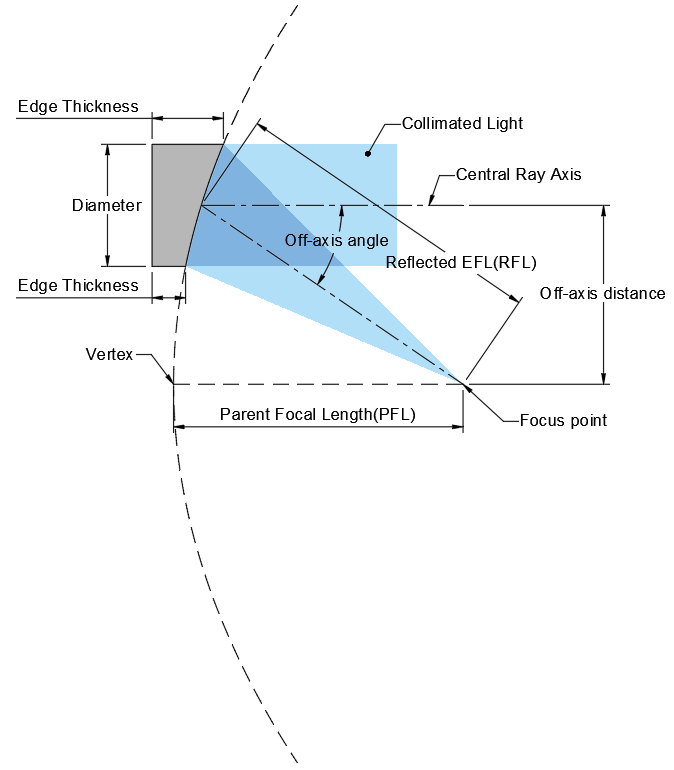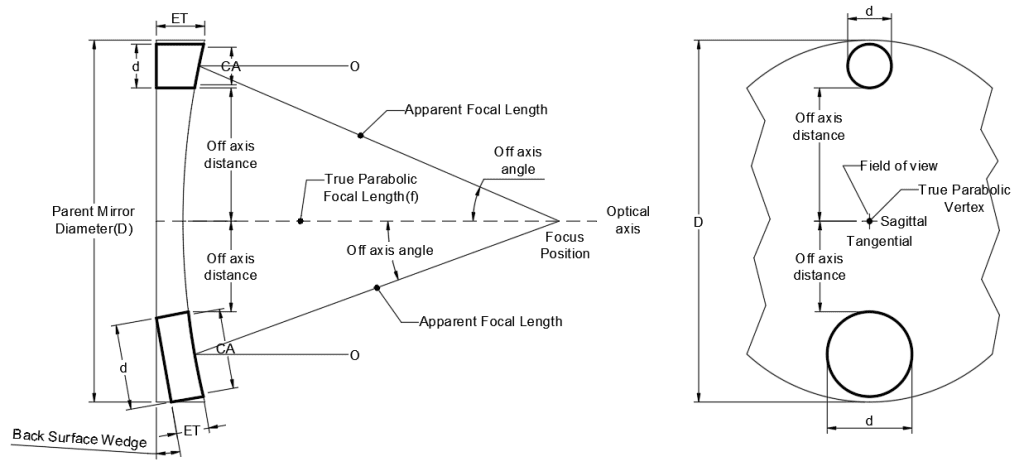Design of an Off-Axis Parabola Mirror
Off-axis parabolic mirrors, commonly referred to as OAP mirrors, are engineered to manipulate parallel light beams. Unlike standard flat mirrors, they leverage a parabolic section to achieve specific optical functions.
- Collimation: When a divergent light beam meets the OAP mirror parallel to its optical axis, the parabolic surface collimates the light, rendering it into a uniform parallel beam. This property proves beneficial for applications demanding precise, well-defined beam paths.
- Focusing: Conversely, a collimated beam directed parallel to the optical axis of the OAP mirror converges to a focal point upon reflection. This focusing capability finds applications in concentrating light energy onto specific areas within various optical systems.
The crux of OAP mirror design lies in the orientation of the incident beam. To achieve collimation or focusing, incoming light must be parallel to the mirror’s optical axis, defined by the curvature of its parabolic section.

An Off-Axis Parabola (OAP) mirror is a segment of a parabolic mirror positioned away from the main axis. It enables precise focusing of light and eliminates chromatic aberrations, making it versatile for optical designs.
Advantages of OAP Mirrors
These mirrors, akin to other off-axis mirrors, are sections cut from a larger, ideal parabolic mirror (parent parabolic mirror). This design offers several advantages:
- Achromatic Focusing: Capable of focusing light of various wavelengths at the same point, eliminating chromatic aberration.
- All-Reflective Design: Reflecting all light instead of transmitting it, they minimize phase delays and avoid absorption losses inherent in lenses. This makes them ideal for applications utilizing ultra-short pulsed lasers.
Construction and Parameters
- Coating: The parabolic surface is diamond-turned and coated with a protective silver layer, reflecting over 97% of light from 450 nanometers to 2 micrometers and over 95% of light from 2 micrometers to 20 micrometers.
- Material: Aluminum substrates are used for construction, with non-reflective surfaces black-anodized for stray light reduction. They are laser-engraved with an item number for easy identification.
Key Parameters
Understanding key parameters is crucial for designing and utilizing OAP mirrors effectively:
- Parent Focal Length (f): The focal length of an ideal parabolic mirror if it were not cut off-axis.
- Segment Focal Length (f’): The focal length of the specific off-axis section, generally different from the parent focal length due to the off-axis nature.
- Off-Axis Angle (θ): The angle between the axis of the complete parabolic mirror (parent axis) and the axis of the off-axis segment.
- Off-Axis Distance (d): The distance between the vertex of the complete parabolic mirror and the vertex of the off-axis segment.

Design Approaches
The design of Optical Axis Paraboloids (OAP) can be approached through two main methodologies:
- Wedged Design: Aligning the mechanical reference with the collimating beam. This approach poses challenges for large off-axis angles due to the requirement for an exceedingly thin wedge shape.
- Non-Wedged Design: Utilizing the segment axis as the mechanical reference, simplifying the design process for OAPs intended for large off-axis angles. However, it may present minor alignment challenges.
Custom Solutions by Avantier
At Avantier, we create custom Off-Axis Parabolic Mirrors to match specific needs, offering a range of high-quality coated options in various sizes and features. Mastering these mirrors opens up endless possibilities in optics for precise light manipulation across diverse applications.
GREAT ARTICLE!
Share this article to gain insights from your connections!

